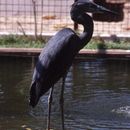Biology
provided by Arkive
Standing motionless, typically solitary, in shallow water (2), the Madagascar heron is a patient hunter (2), which uses its keen eyesight to scan the surrounding water for signs of movement below the surface (3). With its head bent into an s-shape, upon spying its prey, the heron rapidly shoots its head forward and captures the fish in its dagger-like bill (3). It feeds primarily on medium to large fish, around 1.5 times the size of its bill, but has also been reported to take eels, up to 48 centimetres long (2), and crustaceans (4).
The breeding season of the Madagascar heron is not entirely clear (2), although it is possible breeding takes place year round (4). It may breed in small colonies, with other species or solitary, and constructs a nest in the tree-tops or in a hollow in a rock, where it lays three eggs (4).
Conservation
provided by Arkive
Fortunately, the Madagascar heron occurs in four protected areas in west Madagascar (2), including Ankarafantsika Strict Reserve, Ankarana Special Reserve and Baly Bay National Park, but with around 50 percent of the global population living outside protected areas (4), clearly more needs to be done. Surveys to locate important nesting and feeding sites of the Madagascar heron have been recommended (2) (4), as well as the effective protection of known sites, and further research to determine this species' biology and conservation needs (2). The rarity of this Endangered bird makes it one of the heron species most in need of protection and conservation (2); hopefully suitable and effective conservation action will be implemented in the near future.
Description
provided by Arkive
This large grey heron may be seen standing solitary and motionless in shallow waters, a habitat that it is perfectly adapted for. Its long, brown legs allow the Madagascar heron to keep its dull grey plumage dry as it extends its long neck to feed (2) (3). Like other herons, its feet have four widely spaced toes; the webbing of the front three toes spreads the bird's weight as it walks across soft muddy or marshy ground (3). The crown, sides of the head, and chin are black, a feature which allows this heron to be distinguished from similar species (2). The large, long straight bill of the Madagascar heron, which tapers to a dagger-like point, is typically yellow (2) (4), but tends to orange during the breeding season (4). Juvenile Madagascar herons differ slightly in appearance from adults, as they have very dark plumage and white to brownish chins (2).
Habitat
provided by Arkive
This wetland specialist prefers coastal habitats, including tidal mud flats, shallow bays in mangrove swamps, and estuaries (2) (4). However, it also visits freshwater lakes and rivers, and rice fields (2) (4). The most important habitat requirements for this bird are clear, shallow water, and the presence of large fish on which to feed (4).
Range
provided by Arkive
The Madagascar heron breeds only on Madagascar, but it has also been recorded on the Comoro Islands and Mayotte (4). On Madagascar, it principally occurs along the west coast; it may also occur in the east of the island, but there are few recent records of the heron in this region (2).
Status
provided by Arkive
Classified as Endangered (EN) on the IUCN Red List (1).
Threats
provided by Arkive
Although it is likely that the Madagascar heron was never particularly abundant (2), a variety of human activities have made this bird extremely rare, placing it at risk of extinction (4). Wetland habitats in Madagascar have been lost to conversion to rice cultivation, and degraded by siltation as a result of deforestation in the surrounding land (4). The collection of the heron's eggs and the capture of nestlings by local people for food is also impacting heron populations (2) (4), and these damaging activities are only expected to increase as the human population in western Madagascar continues to rise (4). The depletion of the heron's prey by local fisheries is also a potential threat (4). Finally, wetlands in Madagascar have been declining for a long time as the climate has become increasingly drier (4), hinting at the negative impact global climate change could have on this species.
Humblot's heron
provided by wikipedia EN
Humblot's heron (Ardea humbloti), also known as the Madagascar heron, is a species of heron. In Madagascar, it is common on the north and west coasts of the island, but is also found inland, especially near Lake Alaotra. It is also present in the Comoro Islands and Mayotte. Humblot's heron is an endangered species, with a population estimated at only 1,500 mature individuals. Its population is apparently declining. The major threats the heron faces are poaching (both the bird itself and its eggs) and habitat destruction (the cutting of nesting trees and the disappearance of wetlands.)
The scientific name commemorates the French naturalist Leon Humblot.[2]
References

- license
- cc-by-sa-3.0
- copyright
- Wikipedia authors and editors
Humblot's heron: Brief Summary
provided by wikipedia EN
Humblot's heron (Ardea humbloti), also known as the Madagascar heron, is a species of heron. In Madagascar, it is common on the north and west coasts of the island, but is also found inland, especially near Lake Alaotra. It is also present in the Comoro Islands and Mayotte. Humblot's heron is an endangered species, with a population estimated at only 1,500 mature individuals. Its population is apparently declining. The major threats the heron faces are poaching (both the bird itself and its eggs) and habitat destruction (the cutting of nesting trees and the disappearance of wetlands.)
The scientific name commemorates the French naturalist Leon Humblot.
- license
- cc-by-sa-3.0
- copyright
- Wikipedia authors and editors

